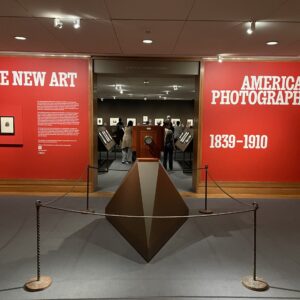JTF (just the facts): A total of 6 large scale photographic works, framed in raw oiled steel and unmatted, and hung against white walls in a smaller side gallery. All of the works are UV prints on canvas, made in 2024. Each is sized roughly 64x43x2 inches and is unique. (Installation shots below.)
This is the artist’s first solo show in the United States.
Comments/Context: There’s something strangely seductive about the twisted metal of crashed and junked cars that’s like compositional catnip for artists. When faced with the tactile aftermath of violence, a voyeuristic instinct seems to kick in, and our eyes linger on the rough surfaces of dented metal, smashed glass, and scraped paint, processing the visual evidence and imagining the forces that caused such damage. Framed by the flattening eye of the camera, fragmented car wrecks can become almost abstract gestural exercises, with the charged mood of destruction and even death never far from view.
For Kelly Tissot, the stock car races held in rural France in the summer have provided plenty of raw material for photographic exploration. Since 2016, the French-born, Basel-based artist has been documenting the smashed cars after the races, reveling in the surfaces, textures, and contrasts to be found there. Working in sun-blasted black-and-white, Tissot delves into the crusty mechanical ruins, excavating the devastation in search of resonant ferocity.
Compositionally, Tissot generally settles into a comfortable mid range, neither stepped back to take in the entire form of a wrecked car, nor cropped down to narrower views of specific details. This leads to images of hollowed out window and door frames, angled wheel wells, crunched protective mesh, and crumpled hoods and dented side panels covered in mud, with a few looks through empty windshields into darker interiors. In several cases, the cars have been parked tightly together, so Tissot can craft a view that stacks one car in front of another, layering the sculptural forms together. Along the way, she highlights painted numbers, stars, and letters, gestural breaks and twists of steel, the machinery of blown out engines, the curves of rubber tires, and the dirty splatters that have splashed across all the available surfaces, almost like paint or blood. Her photographs are identifiably representational, but edge toward lyrical abstraction, with frames cut into pieces by intruding angles and bold contrasts of light and dark.
Tissot presents her photographs as large scale works printed on canvas and framed in steel. The metal frames literally echo the materials in the pictures, and the canvas adds a nubby almost monochrome Warholian quality to the already texture-rich photographs. Tissot then goes one step further toward abstraction by deliberately misaligning the arrangement of the images, combining two separate photographs into a single montage, where one image takes up most of the frame and a second comprises perhaps one-quarter to one-third of the total space, like a film strip or contact sheet that has shifted. Each work is a divided combination of two photographs, creating a staggered dialogue between specific formal elements and tonal qualities. This expressive duality pushes further away from straightforward representation, piling fleeting impressions of past violence on top of one another, like the transitions of a slide show.
Tissot’s interest in demolished vehicles follows in a decently long photographic tradition. Photographers like Enrique Metinides (reviewed here) and Arnold Odermatt photographed car accidents and smash ups with an eye for both sensational violence and artistic form, while Danny Lyon and Martin Bogren (reviewed here) (among others) have pointed their cameras at the drivers of stock cars and other amped up trucks, tracking the performative masculinity associated with these events. Nicolai Howalt’s meticulous studies of crashed cars (made in 2009, reviewed here) are perhaps the closest relative to Tissot’s work, although many get inside the cars much more, to explore the cramped environment of deflated airbags and cratered dashboards.
Tissot has carved out her own aesthetic space in this subject matter subgenre by pushing toward a stronger sense of swirling all-over formal interplay, where the destroyed cars are further fragmented and disrupted by her active framing. Her montage approach adds to this instability, moving away from centered attention on a single instant and toward a flipbook of shapes and moments that seem to stream by with almost cinematic flair. While Tissot’s eye is often inspired in terms of her view of the available formal possibilities in the cars, it is the slippery framework of shifting that seems like a durable innovation she can apply to almost any kind of imagery she might care to consider. Her works here not only exist in the current moment, but seem to imply a switch or movement to another alternate configuration, making her compositions more jittery and dynamic. These pictures seem to imply continuous vertical cycling or rotation, the near abstractions pleasingly laying on top of each other like a creaking junkyard pile.
Collector’s POV: The works in this show are priced at $7500 each. Tissot’s work has little secondary market history at this point, so gallery retail likely remains the best option for those collectors interested in following up.








